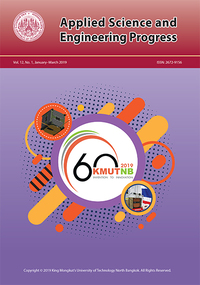Estimating the Parameters of a Two-parameter Crack Distribution
Main Article Content
Abstract
The crack distribution is the mixture of an inverse Gaussian distribution and a length-biased inverse Gaussian distribution introduced by Jorgensen et al. (1991) and Bowonrattanaset et al. (2011). The probability density function of this distribution has a complicated form that is problematic in parameter estimation. Saengthong and Bodhisuwan (2014) try to solve this problem by introducing the new two-parameter crack distribution but the parameter estimate still had a problem. Therefore, optimization techniques had to be used. For this reason, we offer an alternative algorithm, an EM-algorithm, to estimate two unknown parameters of a two-parameter crack distribution which is presented in Saengthong and Bodhisuwan (2014). A Monte Carlo simulation study was conducted to appraise the performance of the proposed EM-algorithm and compared with the quasi-Newton method for the given sample sizes. The results from the simulation study show that the proposed method performed very well for both parameters and provide consistent statistics, while the quasi-Newton method is a poor estimate of the parameter θ.
Article Details
References
[2] R. C. Gupta and O. Akman, “On the reliability studies of a weighted inverse Gaussian model,” Statistical Planning and Inference, vol. 48, pp. 69–83, 1995.
[3] R. C. Gupta and O. Akman , “Bayes estimation in a mixture inverse Gaussian model,” Annals of the Institute of Statistical Mathematics, vol. 47, no. 3, pp. 493–503, 1995.
[4] P. Bowonrattanaset and K. Budsaba, “Some properties of the three-parameter crack distribution,” Thailand Statistician, vol. 9, no. 2, pp. 195–203, 2011.
[5] S. E. Ahmed, K. Budsaba, S. Lisawadi, and A. I. Volodin, “Parametric estimation for the birnbaum-saunders lifetime distribution based on new parametrization,” Thailand Statistician, vol. 6, no. 2, pp. 213–240, 2008.
[6] R. C. Gupta and D. Kundu, “Weighted inverse Gaussian-a versatile lifetime model,” Journal of Applied Statistics, vol. 38, pp. 2695–2708, 2011.
[7] M. Duangsaphon, “Improved statistical inference for three-parameter crack lifetime distribution,” Ph.D. dissertation, Department of Mathematics and Statistics, Faculty of Science and Technology, Thammasat University, 2014.
[8] P. Saengthong and W. Bodhisuwan, “A new twoparameter crack distribution,” Applied Sciences, vol. 14, no. 8, pp. 758–766, 2014.
[9] P. Bowonrattanaset, “Point estimation for crack lifetime distribution,” Ph.D. dissertation, Department of Mathematics and Statistics, Faculty of Science and Technology, Thammasat University, 2011.


